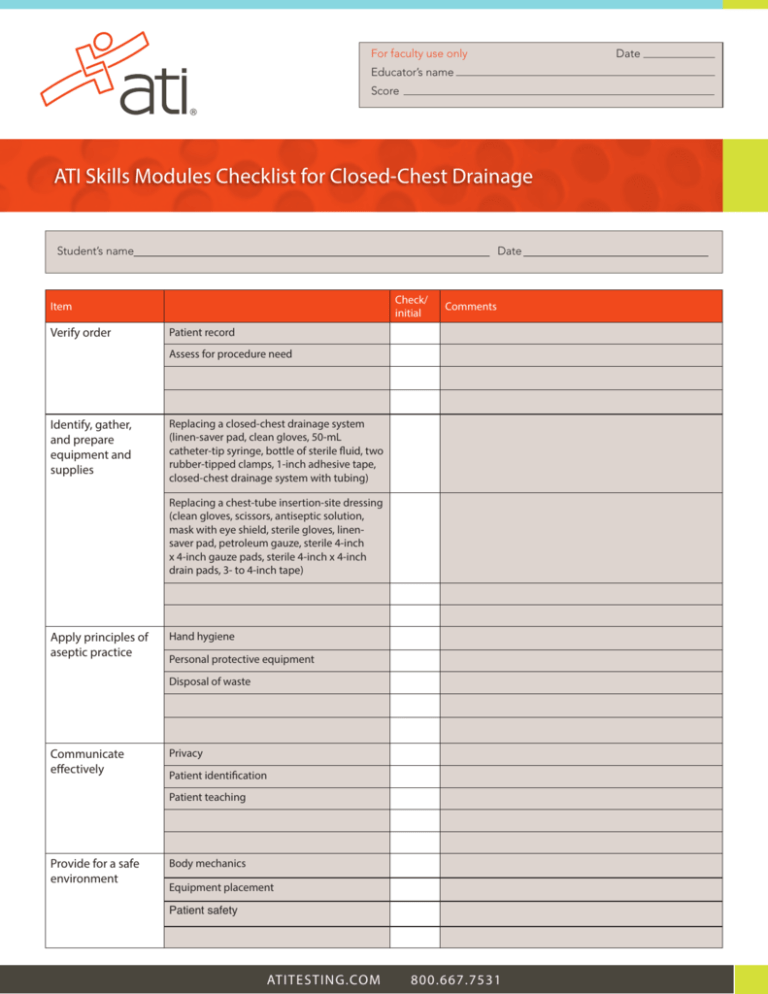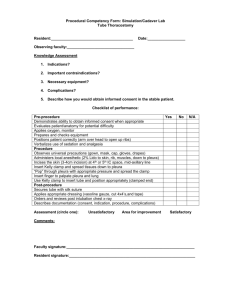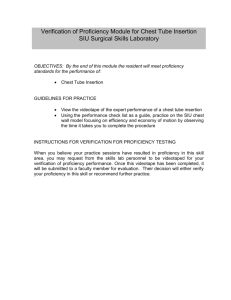Closed-Chest Drainage Skills Checklist | ATI Testing
advertisement

For faculty use only Educator’s name Score ATI Skills Modules Checklist for Closed-Chest Drainage Student’s nameDate Check/ initial Item Verify order Comments Patient record Assess for procedure need Identify, gather, and prepare equipment and supplies Replacing a closed-chest drainage system (linen-saver pad, clean gloves, 50-mL catheter-tip syringe, bottle of sterile fluid, two rubber-tipped clamps, 1-inch adhesive tape, closed-chest drainage system with tubing) Replacing a chest-tube insertion-site dressing (clean gloves, scissors, antiseptic solution, mask with eye shield, sterile gloves, linensaver pad, petroleum gauze, sterile 4-inch x 4-inch gauze pads, sterile 4-inch x 4-inch drain pads, 3- to 4-inch tape) Apply principles of aseptic practice Hand hygiene Personal protective equipment Disposal of waste Communicate effectively Privacy Patient identification Patient teaching Provide for a safe environment Body mechanics Equipment placement Patient safety ATITESTING.COM 800.667.7531 Date Demonstrate procedural steps Item Check/ initial Task Comments Confirm absence of air leak by observing waterReplacing a seal chamber or air-leak meter. (For air leak, do closed-chest drainage system not clamp chest tube.) Raise bed height. Don clean gloves. Open, remove outer wrap of drainage system. Open inner wrap; two sides, then back, then front. Inspect drainage system. Place sterile fluid bottle, mask within reach. Open bottle, discard small amount of fluid. Remove plastic connector from device; attach it to fill chamber. Instill fluid into water-seal chamber to 2-cm mark. Remove cap from suction-control chamber, instill sterile fluid to 20-cm mark, recap suctioncontrol chamber. If unit has air leak meter, add sterile fluid to indicated level. Place linen-saver pad beneath patient. Remove tape reinforcing connection between chest tube and drainage tubing. Remove gloves, perform hand hygiene, don personal protective equipment. Double-clamp tube close to insertion site by placing clamps in opposite directions. Disconnect end of chest tube from old system and reconnect it to new system. Remove clamps from chest tube. Use tape to secure tubing of new system to chest tube. Remove suction tubing from old system and reconnect it to new system. Discard old system and all waste material in appropriate receptacle. Position new system on bed frame. Check for fluctuation in water-seal chamber as patient breathes. Observe oscillation of fluid in suction-control chamber; adjust suction source as necessary to generate gentle bubbling. Assess patient; ensure comfort. ATITESTING.COM 800.667.7531 Demonstrate procedural steps Check/ initial Item Task Replacing a chest-tube insertion-site dressing Assess patient’s pain level. Comments Raise bed height, lower head of bed. Don personal protective equipment (mask, clean gloves). Position patient on unaffected side. Place linen-saver pad beneath patient. Remove dressing, noting color, consistency, amount of drainage on dressing. Discard dressing in appropriate receptacle. Remove gloves, perform hand hygiene, don sterile gloves. Clean around insertion site with antiseptic. Place sterile petroleum gauze around chest tube at insertion site. Place drain pad across chest tube. Use gauze pads around chest tube to create even surface. Place tape so that it adheres firmly against chest wall adjacent to chest tube. Place end of tape firmly against chest wall on opposite side of chest tube. Repeat until entire dressing is covered and sealed. Assess patient; provide comfort. Discard used materials. ATITESTING.COM 800.667.7531 Documentation Item Task Document per facility policy Chest-tube insertion: Check/ initial Comments Informed consent Date, time of insertion Anatomical location of insertion Size of tube Reason for insertion Breath sounds, respiratory rate and depth, oxygen saturation before and after insertion Characteristics, amount of chest tube drainage Dressing application, status Any complications For patients going home with mobile drainage device: instructions, contact information, follow-up appointments Chest-tube and drainage system maintenance: Schedule for drainage checks, dressing changes Status of insertion site, surrounding skin Type of dressing Drainage on dressing Dressing change time, date Respiratory assessment Characteristics, amount of chest tube output Functioning of closed-chest drainage system Any procedural changes (reduction in suction, open to water seal) Strategies to promote ventilation, oxygenation (head of bed elevation, incentive spirometry, positional changes, ambulation) Pain level, interventions for pain management Chest-tube removal: Date, time of removal Breath sounds, respiratory rate and depth, oxygen saturation before and after removal Characteristics, amount of chest-tube drainage Dressing application, status Any complications ATITESTING.COM 800.667.7531 Comments ATITESTING.COM 800.667.7531



